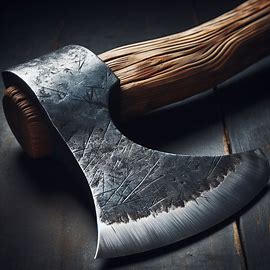Table of Contents
Introduction
The Significance of Viking Axes in Norse Culture
Evolution of Viking Axe Design
3.1 Traditional Materials and Techniques
3.2 Introduction of Carbon Steel
Characteristics of Carbon Steel Viking Axes
4.1 Durability and Strength
4.2 Versatility in Use
4.Three Maintenance and Care
Cultural and Symbolic Importance
5.1 Rituals and Ceremonies
5.2 Depictions in Norse Mythology
5.Three Role in Viking Society
The Legacy of Carbon Steel Viking Axes
Conclusion
1. Introduction
The Viking axe holds a mythical status inside the annals of records, symbolizing the electricity, resilience, and conquest of the Norse human beings. Among the various iterations of this iconic weapon, carbon steel Viking axes stand out for his or her remarkable craftsmanship, sturdiness, and symbolic energy. In this text, we discover the iconic legacy of
carbon steel Viking axes, analyzing their importance in Norse subculture, their evolution over time, and their lasting effect on history.
2. The Significance of Viking Axes in Norse Culture
In Norse culture, the awl held a relevant function as both a tool and a weapon. From everyday responsibilities inclusive of woodworking and farming to the chaos of warfare, the awl became essential to Viking life. It represented no longer most effective sensible software but also symbolic strength, embodying the power, braveness, and martial prowess of the Norse humans.
3. Evolution of Viking Axe Design
3.1 Traditional Materials and Techniques
Historically, Viking axes were made from iron, bronze, or different metals the use of strategies surpassed down through generations of professional blacksmiths. These axes have been ambitious guns of their very own proper, capable of delivering devastating blows in warfare at the same time as additionally serving as versatile equipment for ordinary obligations.
3.2 Introduction of Carbon Steel
In latest years, carbon metallic has emerged as a favored fabric for crafting Viking axes due to its superior electricity, durability, and ease of polishing. Unlike traditional materials, carbon metal offers extra resistance to put on and corrosion, making it best for prolonged use in harsh environments. The advent of carbon steel has revolutionized Viking axe layout, allowing for extra finely crafted and reliable weapons.
4. Characteristics of Carbon Steel Viking Axes
4.1 Durability and Strength
One of the important thing blessings of carbon metallic Viking axes is their awesome durability and strength. The high carbon content of this alloy enhances its hardness and durability, permitting the axe to withstand the pains of fight and everyday use with out succumbing to put on or harm. This durability guarantees that carbon metallic Viking axes are constructed to last, capable of enduring for generations with proper care.
4.2 Versatility in Use
Carbon metallic Viking axes are renowned for their versatility in both battle and every day lifestyles. With a eager part and strong creation, those axes excel at slicing wood, clearing brush, and other outdoor tasks. In fight, they supply effective blows which can cleave thru armor and flesh alike, making them bold guns in the palms of professional warriors.
4.3 Maintenance and Care
While carbon steel gives superior performance, it also calls for proper protection to prevent rust and corrosion. Owners of carbon steel Viking axes ought to often easy and oil their weapons to protect them from the factors. Additionally, axes should be sharpened often to hold their aspect and effectiveness in war.
5. Cultural and Symbolic Importance
51 Rituals and Ceremonies
In Norse society, the awl held deep cultural and symbolic significance. It changed into regularly utilized in rituals and ceremonies to honor the gods, celebrate victories in conflict, or mark essential occasions which includes weddings and funerals. The craftsmanship and design of carbon metallic Viking axes made them prized possessions, surpassed down thru generations as heirlooms and symbols of familial pride.
5.2 Depictions in Norse Mythology
The awl featured prominently in Norse mythology, in which it turned into related to gods such as Odin, Thor, and Frey. These deities were respected as patrons of conflict, energy, and fertility, and the axe served as a image in their divine power. Warriors frequently invoked the names of these gods earlier than warfare, seeking their protection and blessing for victory.
5.3 Role in Viking Society
In Viking society, the awl played a multifaceted position as both a device and a weapon. It was used for sensible purposes consisting of constructing ships, constructing houses, and crafting fixtures, as well as for more martial hobbies including raiding, pillaging, and conquest. The axe became a ubiquitous presence in everyday existence, reflecting the rugged and resourceful nature of the Norse humans.
6. The Legacy of Carbon Steel Viking Axes
The legacy of carbon metal Viking axes endures to nowadays, serving as a tangible link to the storied past of the Norse humans. These weapons of way of life and strength hold to captivate imaginations, inspiring artists, craftsmen, and historians alike. From museum famous to modern replicas, carbon metallic Viking axes stand as testament to the long-lasting craftsmanship and martial spirit of the Vikings.
7. Conclusion
In end,
carbon steel Viking axes are extra than mere guns – they are gear of subculture and energy, embodying the electricity, resilience, and ingenuity of the Norse people. Crafted to remaining and imbued with cultural importance, these axes serve as tangible reminders of a bygone technology and continue to inspire admiration and awe inside the contemporary. As we honor their legacy, we pay homage to the soldiers, craftsmen, and storytellers who solid them, making sure that their testimonies undergo for generations to come.







